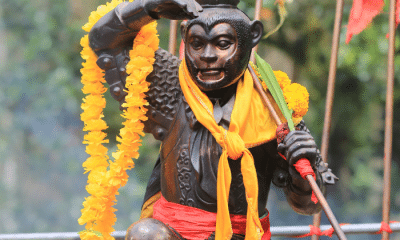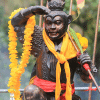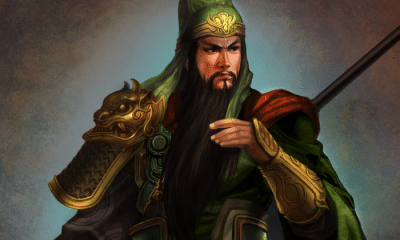Chinese
Mazu: The Chinese Goddess of the Sea
The Chinese protectress of the sea is a goddess who is recognized across faiths, philosophies, and borders!
Mazu is one of the principal goddesses of Chinese folklore. Said to be the deified form of a young woman from 10th century Fujian, Mazu is a protective goddess who is most closely associated with travel by sea.
Her legend seems to have arisen out of shamanistic beliefs of coastal Fujian, but the story was soon incorporated into China’s main religious philosophies. She is today recognized as a deity in both Taoism and Chan Buddhism.
Travelers have established her shrines throughout the world in addition to incorporating her into Buddhist and Taoist temples. In Taiwan alone she has almost a thousand temples!
So who was the historic Mazu and how did her cult spread so far?
The Origin and Miracles of Mazu
Mazu was said to have been born by the name of Lin Mo or Lin Moniang on Meizhou Island off the coast of Fujian. Her birth is generally dated to the year 960, during the Min Kingdom.
Most legends claimed that she was the daughter of a fisherman who was well-liked in the village. She was his sixth or seventh daughter.
In some versions of her legend, the bodhisattva Guanyin sent Lin Moniang to her parents even though they had prayed for a son. Some stories even claimed that Guanyin was reincarnated as the young girl.
Lin Moniang was a quiet and studious child who devoted herself to religious studies. By age eleven she had mastered the study of Confucius and the primary Buddhist sutras.
Some legends claim that she was visited at age thirteen by either a Buddhist monk or a Taoist master who recognized the divinity within her. He gave her a book of hidden lore which she soon mastered as well.
By age sixteen, Lin Moniang had the ability to see the future and travel both spiritually and physically across great distances at will. Further study allowed her to exorcize demons, heal the sick, and bring rain to prevent drought.
During this time, Lin Moniang was known to wear a red dress and stand on the shore of Fujian. She guided ships to safety in even the harshest weather.
In one of her most popular legends, Lin Moniang saved her own family from disaster during a typhoon. Although she was at home weaving, her ability to travel on the spiritual plane enabled her to save her father and brothers from drowning at sea.
According to some versions of the story, however, Lin Moniang’s mother interrupted her when she entered the trance-like state that allowed her to travel in this way. Her spirit dropped either one of her brothers or her father.
One version of her legend claims that she also died three days later in a failed attempt to rescue her father. The people of Nangan Island claim that her body washed ashore and was buried there with honor.
Most, however, say that she lived to be 28 years old and died in meditation. Many say that was taken to Heaven in a bright light at the moment of her death, becoming a goddess.
After her death, Lin Maniang was given the name Mazu, which translates to “Maternal Ancestor.” She is called the mother or grandmother of her followers, as well as the Princess or Queen of Heaven.
Despite this, however, Mazu is known as a virgin goddess. In some traditions, her refusal to marry was a vow made after she failed to save her brother from drowning.
A few local legends even claimed that Lin Moniang died in an attempt to avoid a forced betrothal.
One of the myths Mazu was incorporated into later centered around her refusal to marry. Two demons, Qianliyan and Shunfeng’er, both asked for Mazu’s hand in marriage.
The goddess said that whichever of the demons could defeat her in hand to hand combat would earn her hand. She easily defeated them both, however, and maintained her celibacy.
Mazu then hired the two demons as her personal guardians. They are sometimes shown on the doors of her temples as her military protectors.
My Modern Interpretation
The legend of Mazu includes references to virtually all of China’s belief systems.
She was said to have been a shamaness of Fujian who was born during a time when refugees from Han China began to heavily influence the local culture.
The traditional shamanism that was likely practiced in Fujian at the time gave way to a mixture of Buddhist and Taoist beliefs, which by the 12th century were central to Mazu’s story.
While Taoism and Buddhism are still recognized as separate belief systems, they greatly influenced one another in China. Along with Confucianism, many of their philosophies and beliefs intermingled over time.
All of these philosophies also adopted aspects of traditional Chinese folklore. As a result, they share many legends and rituals.
The various legends of Mizu show this combination of beliefs. She was said to have studied and mastered the texts of all three traditions.
Mazu thus came to be recognized in Taoism, Chan Buddhism, and Neo-Confucianism. Details of the story, such as her visit with a Taoist master or the involvement of Guanyin, are only subtly changed based on the religion that the text originated in.
In some accounts, Mazu was so revered that even Muslims in China recognized her. General Zheng He credited Mazu with protecting him on one of his expeditions in the early 15th century and asked the emperor to build a palace in her honor in Nanjing.
Over time, belief in Mazu spread to such an extent that other goddesses and shamanistic figures were incorporated into her mythos. She became not only a protector of sailors but also of women in childbirth, an averter of both floods and droughts, and a healer of diseases.
Because she protected people at sea, Mazu was often one of the first deities recognized by Chinese people as they moved overseas. This spread Mazu’s cult around the world.
Today, Mazuism is one of the most widespread beliefs among people of Chinese descent, particularly those living abroad. Some Chinese vessels still carry a small shrine or effigy of Mazu to ensure a safe crossing and her temples are some of the most numerous in the world.
In Taiwan, where the people traditionally consider themselves to be descended from Fujian settlers, Mazu has nearly a thousand dedicated temples. Roughly 500 more temples are scattered around the world.
On Macau, she is known as A-Ma, which likely gave the island its name in English and Portuguese. Australia’s largest Chinese temple is dedicated to her and new temples in the United States and Japan have been dedicated well into the 21st century.
Her appeal across the traditional faiths and philosophies of China continues to be seen. In Taiwan, her temples are variously registered as either Buddhist or Taoist.
In mainland China, however, Mazuism is seen as a cult outside the purview of either religion. Her worship is generally permitted, although not encouraged, by the state and over a hundred temples of Mazu remain in Fujian alone.
In Summary
According to legend, the goddess Mazu was born in the year 960 in a fishing village in Fujian province. Called Lin Mo or Lin Moniang in life, she was said to have mastered the study of Confucianism, Buddhism, and Taoism by her teenage years.
Throughout her life, Mazu was said to have performed many miracles. She was most well-known for guiding ships to shore during storms, even saving her own family from drowning by rescuing them in spirit form.
As a goddess, Mazu’s protective aspect increased. Her cult spread and expanded to incorporate other legends, making her one of Chinese mythology’s principal protective deities.
This spread was furthered by the fact that her legends were repeated in both Buddhist and Taoist writings. Today she continues to be recognized by both faiths.
As a protector of travellers, hers were among the first temples established by Chinese people overseas. This has enabled Mazuism to spread well beyond its roots in Fujian to other Asian countries, Australia, and the United States.









